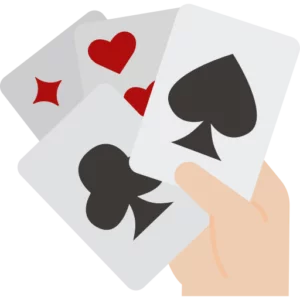Glossary Term
Rake
Rake
Used In: Poker
Introduction
In poker, rake is the fee that a casino or poker room charges players for running the game. It is usually taken as a small percentage of the pot in each hand, or as a fixed fee per player per hour in some cases. The rake serves as the primary source of revenue for the house, allowing the venue to cover operating costs like staff, facilities, and services without competing directly against the players.
The way rake is collected varies depending on the game format and location. In cash games, the rake is typically taken from each pot above a minimum size, often capped at a maximum amount to keep fees reasonable. In tournament play, the rake is usually included in the buy-in fee rather than deducted from pots. Online poker sites may use different methods, such as charging a percentage of total bets or a fixed fee per hand.
Understanding rake is important for poker players because it affects long-term profitability. Even though the fee may seem small on each hand, it can add up significantly over time, especially for frequent players. Skilled players factor rake into their strategy and bankroll management to ensure they remain profitable despite these costs.
-
Rake is the fee taken by the house or poker room from each pot or buy-in to cover operating costs.
-
It’s usually a small percentage of the pot in cash games or included in the tournament buy-in fee.
-
Rake affects player profitability and must be considered in long-term strategy and bankroll management.
In Depth Look
Rake is essentially the house’s commission for facilitating poker games, and it plays a critical role in the economics of both live and online poker rooms. The most common method of collecting rake in cash games is taking a percentage of the pot—often between 2.5% and 10%—once the pot reaches a minimum size. To prevent excessive fees, many venues cap the rake at a maximum amount per pot, which varies depending on the stakes. This system ensures the house earns revenue while keeping the game fair and attractive to players. In some cases, especially in live games, rake might also be collected as a time-based fee per player per hour, known as a “time rake,” rather than from each pot.
The rake structure can vary widely across different poker rooms and formats, affecting the overall cost of playing. Tournament rake is generally embedded in the buy-in—players pay a higher upfront fee that includes the prize pool contribution plus the house fee. Online poker sites often have flexible rake systems, sometimes offering promotions or reduced rake to attract players. Understanding these differences is important because higher rake rates can significantly reduce player winnings, especially in lower-stakes games where pots tend to be smaller. Players who frequently play in high-rake environments must adjust their strategies accordingly to maintain profitability.
From a player’s perspective, rake is one of the biggest obstacles to consistent winning. Even highly skilled players face challenges overcoming the built-in cost of rake, which acts like a tax on every hand played. To offset this, players need to focus on making profitable decisions that can outweigh the fees, often requiring tight bankroll management and careful game selection. In some cases, players seek out games with lower rake or rakeback promotions to improve their expected value. Ultimately, a clear understanding of how rake works—and how it affects expected returns—is essential for anyone serious about poker as a long-term endeavor.
Mechanics
Rake is typically collected during cash games by taking a small percentage of the total pot once it reaches a certain minimum size. For example, a poker room might take 5% of the pot from every hand over $20, up to a maximum cap—often around $3 to $5—so that the fee doesn’t grow excessively with very large pots. The rake is usually taken after the hand ends but before the pot is awarded to the winner. In some live games, instead of taking a portion of each pot, the house charges a fixed fee per player every half hour or hour, known as a time rake, which simplifies the collection process but works similarly as a house profit source.
In tournament play, the rake is handled differently: rather than taking a cut from individual pots, the house adds a fee to the buy-in. For instance, a tournament might cost $100 to enter, with $90 going to the prize pool and $10 as the rake fee. This means the house earns its revenue upfront and players compete for the entire prize pool. Online poker platforms may also implement different rake systems, such as charging a fee per hand or using a “weighted contributed” method where players pay rake proportional to their involvement in the pot. Understanding these mechanics helps players recognize how rake impacts their expected returns and informs decisions about which games to play.


Illustrated Example
Imagine a cash game where the poker room takes a 5% rake on pots over $20, capped at $3 per pot. If the pot size is $50, the rake would be 5% of $50, which is $2.50. This means the house takes $2.50 before awarding the remaining $47.50 to the winning player. For a larger pot of $100, the 5% rake would be $5, but since the cap is $3, only $3 is taken. The winner then receives $97. This system ensures the rake remains fair and doesn’t become too expensive as pots grow.
To see how the rake changes with pot size, consider the following table. It shows pot sizes, the calculated rake at 5%, the capped rake, and the amount the winner takes home after rake is deducted. This helps visualize how rake scales with pot size and the effect of the rake cap on larger pots.
| Pot Size ($) | 5% Rake ($) | Rake Taken ($) | Winner's Share ($) |
|---|---|---|---|
| 20 | 1.00 | 0.00 (Below min pot) | 20.00 |
| 50 | 2.50 | 2.50 | 47.50 |
| 60 | 3.00 | 3.00 (Rake cap) | 57.00 |
| 100 | 5.00 | 3.00 (Rake cap) | 97.00 |
Player Perspective
Rake represents a constant cost that directly reduces potential winnings. Even though the percentage taken per pot might seem small, it accumulates over time and can significantly impact profitability, especially for regular players or those playing lower-stakes games with smaller pots. Because rake effectively acts like a built-in house advantage, players must work harder to overcome this hurdle by making more precise decisions and avoiding unnecessary risks. Awareness of rake levels helps players choose games where the fees are reasonable relative to potential winnings, improving their overall return on investment.
Many experienced players also adjust their strategy to account for rake. For example, they may avoid marginal or speculative hands that could lead to small pots with rake eating into profits. Some seek out games with lower rake or participate in promotions like rakeback, which return a portion of the rake paid, effectively reducing the cost of play. Managing bankroll wisely and selecting the right games with favorable rake conditions are crucial steps players take to maintain long-term success despite the constant pressure rake places on their earnings.
Conclusion
Rake is an unavoidable cost in poker that funds the house and keeps games running, but it also directly affects players’ profitability. Understanding how rake works and how it is applied in different formats is essential for anyone serious about the game. By factoring rake into their strategy, game selection, and bankroll management, players can better navigate its impact and improve their chances of long-term success. Ultimately, mastering the effects of rake is a key part of becoming a skilled and profitable poker player.
The Top Online Casinos for Playing Poker
These platforms prioritize player satisfaction by providing intuitive interfaces, seamless gameplay experiences, and robust security measures to ensure a fair and enjoyable environment for all users.
welcome bonus
Welcome package €1,500 + 350 Free Spins
35x wagering (Deposit & Bonus)
Top 5 best casinos
$titl$ is not the Best Choice. Here are some better options:


Author
Branimir Ivanov | Senior News Contributor







